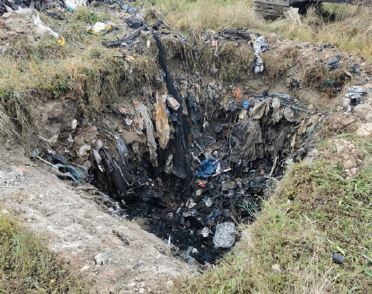
The Council continues to look at the legal options for the remediation of the site, which could be undertaken by the landowner.
The goal of any remediation is to reduce the risk of harm to receptors (residents, the landowner, and the local environment) from the material which is on the site. This can be to reduce the risk of further contamination of the land by way of illegal deposits, and to reduce the exposure to receptors, such as from further fires or trespassing on the site.
There are a number of options available to the landowner which will reduce the impact moving forward.
Fencing
The landowner can install fencing around the perimeter of the site, and planning permission may be needed for this depending on the height and location of the fence. This will help prevent unauthorised access to the site, which may stop fires from starting. The soil sample testing that took place last year found no evidence of a specific source of ignition, so it's possible the fires could have been started manually, instead of through spontaneous combustion.
Fencing should stop any trespassers and should stop or significantly reduce the risk of fires caused by arson, minimising smoke and air pollution from the site.
Fencing should also stop further dumping of waste material from taking place.
CCTV could also be installed around the perimeter fencing to further improve the security of the site.
Capping the land
Capping is the traditional method for remediating landfill sites, and is used internationally to address large volumes of waste with low-levels of contamination.
A cap will not destroy or remove the contaminants but when properly built and maintained will keep them in place to minimise contact of any contaminated material with people and wildlife.
The design and composition of a cap is site specific. A cap design takes into account a number of factors, including what contaminants are present, the area of land affected, the amount of rainfall, underlying geology and any future use of the site.
Caps vary from a single layer of material to several layers of different materials specifically chosen and positioned for the required functionality. For example, if there is concern around water soaking through the layer of waste material, the cap will be designed to reduce this.
Layers can include:
- Layer of vegetation: a top layer of soil and plants to prevent soil erosion, increase the natural look of the area and/or reduce the amount of rain or snow melt that passes through the waste material to the ground underneath
- Drainage layer: this consists of sand, gravel and rows of slotted pipes to collect any water that permeates the top layer of a cap to prevent drainage of rain or snow melt through the waste material below
- Compacted clay: to prevent downward drainage of water
- Geomembrane: a strong plastic-like sheet to prevent downward drainage of water and upward escape of gases
- Collection and venting systems: to prevent build-up of pockets of landfill gases underground
- Concrete: can serve as a building slab foundation/car park.
Regular inspections of the capping layer are recommended to make sure that the weather, plant roots, and human activity have not damaged the layers. If a vegetative layer is installed, inspections are required to ensure that plants on vegetative caps are still growing.
Removal
Removal of the waste material is the third option, however it is the most complicated and expensive and presents significant additional risks to residents and wildlife.
Disturbance of waste at the site is likely to generate significant airborne pollution from dust and odour.
The digging up and transportation of the waste would create considerable further risk of pollutants being released into the atmosphere as the material is transported, possibly over a number of years, to an alternative disposal site. It would also require a significant increase in heavy goods traffic, further impacting the local air quality in Rainham.
Conclusion
Ultimately, remediation of the site is the responsibility of the landowner. The Council is exploring legal options to enforce against the landowner to ensure they carry out their responsibility to remediate the site and minimise the risk to residents.
|